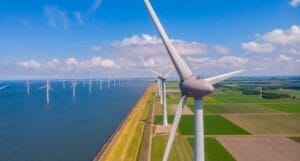Unveiling Photovoltaic Glazing
Photovoltaic glazing is a breakthrough in renewable energy and green technology, marking a significant leap in sustainable design and construction innovation. This technology incorporates photovoltaic cells into building materials, specifically glass technology, to generate solar energy. The integration of photovoltaic cells into construction elements such as windows and facades not only enhances aesthetic appeal but also contributes significantly to energy efficiency. Photovoltaic glazing is a transformative development in sustainable architecture, enabling buildings to generate their own electricity and reduce dependence on traditional energy sources. The potential of photovoltaic glazing extends beyond solar energy production. It also provides thermal and acoustic insulation, UV protection, and improved indoor lighting conditions. The versatility of this technology is remarkable, with applications ranging from residential and commercial buildings to transportation infrastructure. Photovoltaic glazing exemplifies the fusion of functionality and sustainability in modern architectural design, promoting environmental conservation. Despite its numerous benefits, the adoption of photovoltaic glazing is currently limited due to high initial costs and lack of awareness. However, with ongoing advancements in green technology and an increasing focus on sustainable design practices, photovoltaic glazing is poised for significant growth in the future. This technology holds immense potential to revolutionize the energy landscape by harnessing solar power to create energy-efficient buildings.
What are Photovoltaic Cells?
Photovoltaic cells, also known as solar cells, are devices that convert sunlight directly into electricity. These cells are made of semiconductor materials, typically silicon, which absorb photons from sunlight. The absorbed photons excite the electrons in the semiconductor, creating movement and generating an electric current. This process, known as the photovoltaic effect, is the fundamental principle behind the operation of photovoltaic cells and the generation of solar energy. A single photovoltaic cell produces a small amount of electricity. Therefore, multiple cells are combined to form a solar panel to generate a significant amount of electricity. Photovoltaic cells are a key component in solar power systems, enabling the conversion of solar energy into usable electricity. They are a clean, renewable source of energy that can reduce dependence on fossil fuels and contribute to environmental conservation. Photovoltaic cells have evolved significantly over the years, with advancements in materials and designs improving their efficiency and reducing their cost. Modern photovoltaic cells are capable of converting a larger portion of the solar spectrum into electricity, thereby increasing the overall efficiency of solar power systems. Despite challenges such as variability in sunlight and high initial costs, photovoltaic cells continue to be a viable solution for renewable energy generation.

Understanding Conventional and Emerging Systems
Conventional photovoltaic systems, often referred to as first-generation systems, primarily use crystalline silicon photovoltaic cells. These systems have a high efficiency and long lifespan but are relatively expensive to manufacture due to the high purity silicon required. Conventional systems are typically installed on rooftops or in large solar farms to generate electricity. Emerging photovoltaic systems, also known as second and third-generation systems, use alternative materials and technologies to overcome the limitations of conventional systems. Second-generation systems use thin-film technology, which is less efficient but significantly cheaper than conventional systems. These systems are flexible and lightweight, making them suitable for integration into building materials and consumer products. Third-generation systems are still in the experimental phase but hold great promise for the future of solar energy. These systems use advanced materials and technologies, such as organic photovoltaic cells, perovskite solar cells, and quantum dots, to achieve higher efficiencies and lower costs. Emerging photovoltaic systems are expected to play a crucial role in the transition towards a sustainable energy future. In conclusion, photovoltaic glazing is a promising green technology that combines the benefits of photovoltaic cells and building materials to create energy-efficient structures. As this construction innovation continues to evolve, it is expected to play a pivotal role in the global shift towards renewable energy and sustainable development.
Types of Building-Integrated Photovoltaics (BIPV)
Building-Integrated Photovoltaics (BIPV) is a green technology that incorporates solar energy generation into building materials, representing a significant construction innovation. The first type is the amorphous silicon BIPV, a lightweight and flexible solar panel that excels in renewable energy generation in low-light conditions and high temperatures. This type of BIPV, made from non-crystalline silicon, is ideal for complex architectural designs, showcasing sustainable design principles. Crystalline silicon BIPV represents the second type, consisting of monocrystalline and polycrystalline forms. These types of solar panels, made from single or multi-crystal silicon, are known for their high energy efficiency. They are commonly used in large-scale installations, where their power output contributes significantly to environmental conservation efforts. The third type of BIPV is thin-film, which utilizes thin semiconductor materials on glass or stainless steel to create PV cells. Despite lower efficiency, this type of solar panel offers cost and weight advantages, performing well in diffused light conditions. This showcases the versatility of solar energy applications in building materials.
Surprising Buildings Using Photovoltaic Glaze
Photovoltaic glaze, a type of BIPV, is a glass technology that replaces traditional glazing in buildings. The CIS Tower in Manchester, England, is a prime example of this construction innovation. Retrofitted with photovoltaic glaze, the tower became Europe’s largest vertical solar array, demonstrating the potential of renewable energy in urban environments. The Al Bahar Towers in Abu Dhabi also utilize photovoltaic glaze. Their dynamic facade, made of this innovative glass technology, adjusts to the sun’s position to maximize solar gain, contributing to the building’s energy efficiency. The New York Times Building in New York City similarly uses photovoltaic glaze on its roof, showing how solar panels can be integrated into building design for environmental conservation.

Advantages and Misconceptions About PV Glazing
PV glazing offers several advantages over conventional glazing. This green technology generates solar energy, contributes to energy efficiency, and enhances aesthetic appeal. However, misconceptions exist about PV glazing. One is its perceived high cost. While the initial cost may be higher, the long-term energy savings from this renewable energy source can offset this, making PV glazing a cost-effective solution. Another misconception is that PV glazing is less efficient than other solar panels. While it may not match the efficiency of rooftop panels, PV glazing serves a dual purpose as a building material and energy source. This dual functionality can make it a viable option in sustainable design.
What are the Benefits of Photovoltaic Glazing?
Photovoltaic glazing offers significant benefits. As a source of solar energy, it reduces a building’s reliance on the grid and lowers energy costs. It also contributes to energy efficiency by blocking solar heat gain, further reducing energy consumption. This construction innovation is not only practical but also aesthetically pleasing, offering a sleek, modern alternative to traditional glazing. Moreover, photovoltaic glazing contributes to environmental conservation. By generating renewable energy and reducing carbon emissions, it helps buildings meet green building standards. This commitment to sustainable design and green technology can enhance a building’s market value and appeal to environmentally conscious clients or tenants.
Addressing the Cost Misconception of BIPV
The cost of Building Integrated Photovoltaic (BIPV) systems, a cutting-edge construction innovation, is often misunderstood, leading to the misconception that these solar energy solutions are prohibitively expensive. However, a detailed examination of the costs associated with BIPV systems reveals a different picture. While the initial investment required for the installation of these solar panels can be higher than traditional systems, this cost must be viewed within the broader financial landscape of renewable energy solutions. Technological advancements and increased market competition have led to a significant reduction in the cost per watt of BIPV systems. This trend, coupled with the energy efficiency of these systems, is expected to continue, making BIPV an increasingly affordable green technology. Moreover, given the longevity of BIPV systems, which can generate solar energy for 25 years or more, provides a long-term return on investment that can offset the initial installation costs. The integration of BIPV systems into the building envelope can lead to further cost savings by eliminating the need for conventional building materials. This sustainable design approach can lead to substantial savings, particularly in larger construction projects. Additionally, the solar energy generated by BIPV systems can be used to offset electricity costs, providing ongoing savings over the life of the system.
Environmental Impact and Sustainability
The environmental impact of BIPV systems is significantly lower than that of traditional energy sources. These solar panels generate electricity from sunlight, a renewable and abundant resource. This process does not emit harmful greenhouse gases, contributing to environmental conservation and helping to mitigate the effects of climate change. In addition to their environmental benefits, BIPV systems are also a sustainable design solution. The durability of BIPV systems, which are designed to withstand harsh weather conditions and require minimal maintenance, ensures a long lifespan. This longevity, combined with the energy efficiency of these systems, makes BIPV a sustainable investment. The components of BIPV systems, primarily made of advanced glass technology, are mostly recyclable, further contributing to their sustainability. At the end of their lifecycle, these components can be disassembled and recycled, reducing waste and contributing to a circular economy.
Is BIPV the Future of Photovoltaic Systems?
BIPV systems represent a promising future for photovoltaic technology. They offer a unique solution to the growing demand for sustainable energy, combining functionality and aesthetics in a way that traditional solar panels cannot. The integration of BIPV systems into the building envelope allows for a seamless blend with the architectural design, overcoming the aesthetic limitations of traditional systems. The future of BIPV systems is also being shaped by technological advancements. The development of more efficient and versatile photovoltaic materials, such as thin-film technologies, is expected to enhance the performance and applicability of BIPV systems. These advancements, combined with the decreasing costs of BIPV systems, are expected to drive their adoption in the future. The increasing awareness of climate change and the need for sustainable solutions is likely to boost the demand for BIPV systems. Governments around the world are implementing policies to promote the use of renewable energy and are offering incentives for the installation of photovoltaic systems. As a result, BIPV systems are poised to play a crucial role in the global transition towards a sustainable future.

Evaluating and Optimizing PV Glazing Performance
The field of PV glazing, a crucial component in the harnessing of solar energy, requires rigorous evaluation and optimization. The performance of PV glazing, a key element in the renewable energy sector, is influenced by multiple factors. These include the caliber of the glazing material, the design of the solar panels, and the prevailing environmental conditions. Therefore, a comprehensive assessment of PV glazing under diverse conditions is essential for optimizing its energy efficiency. The central focus of PV glazing optimization lies in enhancing the conversion efficiency of sunlight into electricity – a cornerstone of green technology. This can be achieved by utilizing top-notch glazing materials that permit maximum sunlight transmission, incorporating cutting-edge solar panel technologies with high conversion efficiency, and designing the solar panels to maximize sunlight exposure. Furthermore, the performance of PV glazing can be amplified by implementing effective thermal management strategies that prevent overheating of the solar panels. In the context of environmental conservation, the impact of PV glazing is significant. High-performing PV glazing not only generates clean and renewable energy, but also contributes to the reduction of energy consumption in buildings by providing natural lighting and thermal insulation. Consequently, the evaluation and optimization of PV glazing performance should also consider its environmental benefits, reinforcing its prominence in sustainable design and construction innovation.
Assessing System Optimization and Electrical Performance
System optimization and electrical performance are pivotal aspects of PV glazing evaluation. System optimization involves refining the design and configuration of the solar panels and the glazing system to maximize their performance. This includes optimizing the size, shape, and arrangement of the solar panels, the thickness and transparency of the glazing material, and the positioning and orientation of the glazing system – a testament to the importance of innovative building materials in construction innovation. The electrical performance of PV glazing, a key factor in energy efficiency, is determined by its ability to convert sunlight into electricity. This is measured in terms of output voltage and current, power conversion efficiency, and energy yield. These parameters are influenced by the quality and type of the solar panels, the intensity and angle of the incident sunlight, and the temperature of the solar panels. To assess the system optimization and electrical performance of PV glazing, sophisticated testing and measurement techniques are required. These include solar simulator testing, outdoor performance testing, electrical characterization, and thermal imaging. The data obtained from these tests can highlight areas for improvement and aid in the development of strategies to enhance the performance of the PV glazing.
Analyzing Optical and Thermal Performance
The optical and thermal performance of PV glazing are critical determinants of its overall performance. The optical performance pertains to the ability of the glazing to transmit sunlight to the solar panels. It is influenced by the transparency of the glazing material, the refractive index, and the anti-reflective coating. High optical performance ensures that maximum sunlight reaches the solar panels, thereby increasing their power output. The thermal performance of PV glazing relates to its ability to regulate the temperature of the solar panels. Excessive heat can impair the performance of the solar panels and reduce their lifespan. Therefore, effective thermal management strategies are essential. These can involve using thermally insulating glazing materials, incorporating heat sinks or heat exchangers, and optimizing the ventilation of the glazing system. To analyze the optical and thermal performance of PV glazing, various tests and measurements are conducted. These include light transmission measurements, spectral response measurements, thermal conductivity measurements, and thermal imaging. The results of these analyses can provide valuable insights into the performance of the PV glazing and guide the optimization process, further emphasizing the role of glass technology in the advancement of green technology.
Energy Saving, Cost Reduction and Environmental Benefits
Harnessing renewable energy, particularly solar energy, is a leading strategy in energy saving. This green technology offers a sustainable design that effectively reduces energy consumption and costs. Solar panels, a key component of this technology, convert sunlight into electricity, thus providing a renewable and eco-friendly source of energy. The use of solar energy not only reduces reliance on fossil fuels, but also leads to significant cost savings. The cost reduction benefits of solar energy are substantial. By installing solar panels, households and businesses can significantly reduce their energy bills. Moreover, solar energy systems require minimal maintenance, leading to further cost savings. This energy efficiency also contributes to environmental conservation. The use of solar energy reduces greenhouse gas emissions and air pollution, thus promoting environmental sustainability. The environmental benefits of solar energy are equally significant. Solar panels produce clean, green energy that contributes to environmental conservation. This renewable energy source reduces greenhouse gas emissions and minimizes the impact on natural resources. Furthermore, the sustainable design of solar energy systems promotes the efficient use of energy, thereby reducing the demand for energy production and preserving resources for future generations.
Case Study: Innovative Solutions in Practice
Innovative solutions in energy management have proven to be highly effective in practice. A case study that exemplifies this is the incorporation of solar energy systems in the construction industry. The use of solar panels and other green technologies in building materials has resulted in substantial energy savings, cost reductions, and environmental benefits. One such innovation is the use of glass technology that incorporates solar cells. This construction innovation allows buildings to generate their own electricity, leading to significant energy savings. Moreover, this technology contributes to energy efficiency and environmental conservation by reducing the demand for energy production and minimizing greenhouse gas emissions. Another innovative solution is the implementation of energy management systems that optimize the use of solar energy. These systems monitor and control energy usage, maximizing the efficiency of solar panels and reducing energy wastage. The use of these systems has led to significant cost reductions and environmental benefits. They have also enhanced operational efficiency, leading to improved business performance. In conclusion, the application of innovative solutions in energy management, particularly the use of solar energy and green technologies, has demonstrated substantial benefits in practice. These solutions have not only resulted in energy savings and cost reductions but have also contributed to environmental sustainability. This case study serves as a testament to the potential of innovative solutions in achieving energy efficiency and sustainability.




